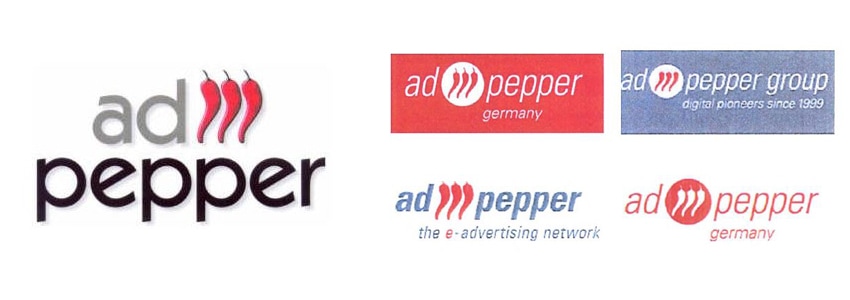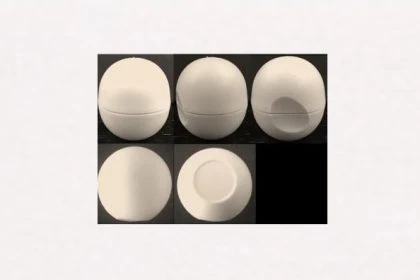Proof of genuine use of a trade mark must be furnished for the trade mark as registered. This is not always easy, because a trademark changes in the spirit of the times and marketing. Proof of genuine use is only possible with a slightly different trademark representation of the form if the distinctive character is not influenced.
The facts
In September 1999 the intervener, ad pepper media International NV (Germany), filed an application for registration of the sign “ad pepper” as a Unionmark for, inter alia, services of an advertising agency and an online provider, web hosting, web design and access to digital networks.
16 years later, in December 2015, the applicant, 6Minutes Media GmbH (Germany), filed an application with the EUIPO for revocation of that trade mark (now under Article 58(1)(a) of Regulation 2017/1001). The applicant argued that the contested mark had not been put to genuine use in the European Union for an uninterrupted period of five years in respect of all the services for which it had been registered.
Proof of genuine use of the mark
If such an allegation is made, the trade mark applicant must prove and prove genuine use of his trade mark. This is not always easy even for well-known brand manufacturers, because a brand changes over time in order to be adapted to the zeitgeist, the marketing and also the goods or services. Proof of the use of a trademark must, however, be furnished for the trademark as it was registered. However, Article 18(1)(a) of Regulation 2017/1001 also permits the use of a trade mark with a slightly different representation as proven if the distinctive character of the trade mark is not thereby affected.
Read also in this context: Adidas loses trademark protection for 3-stripe mark before the CFI
The Cancellation Division revoked the Unionmark for lack of genuine use, but this decision was annulled by the EUIPO Board of Appeal (20 June 2018, “contested decision”). The Board of Appeal rejected the application for revocation of the contested mark. The documents submitted showed that the mark had been sufficiently used.
The European Court (CJEU), before which the plaintiff 6Minutes Media GmbH challenged the decision, also focused on whether the extent of the use was sufficient due to the evidence with deviating trademark representation and variations of the form of the Unionmark.

Proof of genuine use of a trademark
The CJEU summarised the essential elements for the proof of genuine use of a trademark. The assessment had to be made on the basis of all facts and circumstances which could prove the actual commercial exploitation of the mark, in particular that the mark was used to create or secure an outlet for the goods and services claimed. Just as a trademark is protected in the territory in question, it must be put to public and external use. Even a small volume of goods or services marketed under the trade mark can be offset by a high frequency or a certain temporal stability of the acts of use of that mark, and vice versa, the Court explained. The turnover achieved and the quantity of goods sold under the earlier trade mark cannot be assessed in absolute terms and even minor use can be regarded as genuine, depending on the business activity, the production or distribution capacity or the degree of diversification of the undertaking.
Dominant verbal elements
In essence, the plaintiff criticised the Board of Appeal for wrongly identifying the word elements “ad” and “pepper” as the most important elements with inherent distinctive character. Those word elements had at most a weak distinctive character, according to plaintiff, as can be seen from the fact that there were more than 200 registered trademarks containing the word element “pepper”.
However, the CJEU contradicted the plaintiff. According to the case-law, the mere fact of such registrations containing the word element ‘pepper’ is not sufficient to weaken the intrinsic distinctive character of an element, since it is not possible in itself to determine to what extent the target public will actually be confronted with marks containing that element.
In addition, the plaintiff 6Minutes Media claimed that the distinctive character of the challenged mark was significantly altered and impaired by the addition of the word elements ‘germany’, ‘digital pioneers since 1999’ and ‘the e-advertising network’ to the signs used. In addition, the design was changed with different font types and formats as well as different colour variations.
However, all three added word elements were assessed by the CJEU as purely descriptive for the services covered by the dispute mark, which were therefore not to be regarded as distinctive. In addition, the added word elements were clearly smaller than the word group “ad pepper” and the added word elements only appeared in some of the evidence. The fact that a registered trade mark is sometimes used with and sometimes without additional elements could be one of the criteria from which it can be concluded that distinctiveness is not affected, the CJEU explained.
Changed design in font type and background colors
The CJEU also considered the design changes to be only insignificant for the overall impression of the dispute mark. The changes in the line arrangement, the typeface and the font format of the word elements differ only slightly from those of the registered mark, the Court clarified, and the use of colour variants with a red, grey or white background was not particularly original either. The use of those basic colours is neither distinctive nor dominant.
Finally, the CJEU dismissed the action in its entirety.
Would you also like to protect your trademark or brand name?
Our attorneys have many years of experience in trademark and patent law and are authorized to represent you before any court in Germany as well as internationally.
If you are interested, please contact us.
Sources:
Urteil EuG EU:T:2019:720 “Ad Pepper”
Image:








Leave a Reply